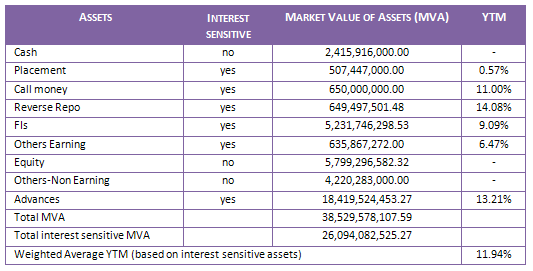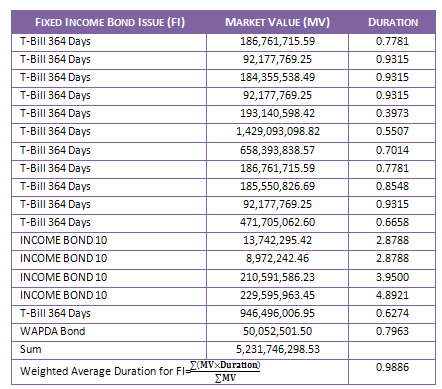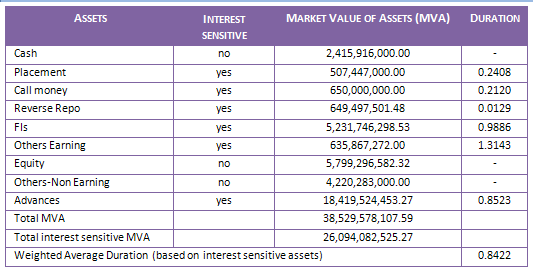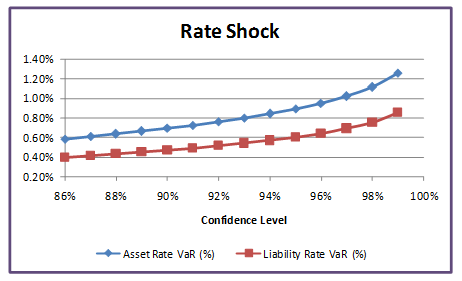Economic value of equity (EVE) at risk or Fall in market value of equity (MVE) depicts a change in the market value of equity due to changes in market values of assets and liabilities. The respective change in assets and liabilities is computed from the interest rate shock derived, based on the value at risk (VaR) approach.
Step 1: Determine look back period
Determine the period over which the risk is to be evaluated. For illustration purposes let us assume a look back period from 1st January 2009 to 30th June 2009, inclusive.
Step 2: Data collection
The data is interest rate data for all available buckets. In our example we use the PKRV rates (these are government treasury rates) at all available buckets for the determined look back period.

Step 3: Calculated the return series
Calculate the returns series for all the interest rate buckets by taking the natural logarithm of the ratio of successive rates. This is determined as follows for the given illustration.

Step 4: Calculate the days to maturity/ days to reset
Calculate days to maturity and in case of floating rate instruments, days to next reset across the balance sheet items. For example in our illustration the days to maturity for the following instruments have been calculated as follows:
Settlement Date = 30/06/2009

Step 5: Calculate individual weights for each asset and liability
Calculate the weights of each individual asset and liability with respect to the total (interest bearing) asset and liability portfolio (based on their MTM). This is done for our example as follows:

Step 6: Obtain return series for each individual asset/ liability
Based on the days to maturity/ days to reset calculated in Step 4 obtain the relevant return series calculated in Step 3 for each individual asset and liability. In our example for the individual asset “Term Finance Certificates” which had 328 days to maturity, this is the return series for interest rate bucket 271-365 days.
Step 7: Calculate weighted average return series for assets and liabilities separately
Using the weights determined in Step 5 and the return series obtained above, weighted average return series for assets and liabilities are derived. In our example, this is illustrated for liabilities as follows:

Step 8: Compute VaR
Using the weighted average series compute the volatilities and Holding VaRs for both assets and liabilities. In our example the volatilities and 10-day holding VaRs at the 90% confidence interval for the asset and liabilities are as follows:

[For a more detailed step-by-step procedure for calculating VaR you may like to review the course “Calculating Value at Risk”].
Step 9: Compute the MTM weighted average yield to maturity (YTM)
Calculate the weight average YTM for assets and liabilities respectively. This is carried out in two stages as follows. Note that the YTMs for individual instruments are based on market rates:
- Step 9a- First; calculate the weighted average YTM for each asset/liability within each asset/ liability category.
- Step 9b- Next; calculate the weighted average YTM of each category to the total (interest sensitive) asset/ liability portfolios.
This is illustrated step-wise for the asset portfolio. Illustration of step 9a:

Illustration of Step 9b:

Step 10: Compute Rate Shock
The rate shock will be calculated using the following formulas:
- Rate-Shock Assets= MTM weighted YTM for assets × Holding VaR for Assets
- Rate-Shock Liabilities= MTM Weighted YTM liabilities × Holding VaR for Liabilities
This is illustrated in our example as follows:

Step 11: Compute the weighted duration of assets and liabilities
Calculate the weighted average duration for assets and liabilities respectively. As for the case of YTM this is carried out in two stages as follows:
- Step 11a- First; calculate the weighted average duration for each asset/liability within each asset/ liability category.
- Step 11b- Next; calculate the weighted average duration of each category to the total (interest sensitive) asset/ liability portfolios.
This is illustrated step-wise for the asset portfolio. Illustration of step 11a:

Illustration of Step 11b:

Step 12: Fall in EVE / MVE
The fall in MVE is calculated as the ‘Fall in Assets’ MTM Value’ less the ‘Fall in Liabilities’ MTM Value’.
- Fall in Assets’ MTM Value = Weighted Duration of assets × Rate Shock Assets × MTM Total Assets[1]
- Fall in Liabilities’ MTM Value = Weighted Duration of liabilities ×Rate Shock Liabilities × MTM Total Liabilities
Our example illustrates this as follows for the 90% confidence level:

The complete range of values for confidence levels 86% to 99% is given in the table below as well as depicted in the following two graphs:



Also see ALM Training for Board and ALCO Members. 7 posts, 60 minutes.

[1] Total Assets and liabilities include interest and non-interest sensitive assets and liabilities.
